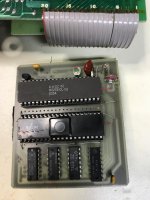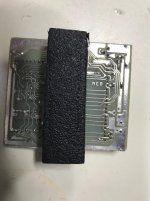Hi,
Some time ago, I procured an older Expansion Interface and it had this plugged into the FDC socket.
I'm trying to figure out what doubler it is. I thought I read years ago that the early Percom units had pots like this one does.
Is this an early Percom Doubler? No identification on it except for "NEB" printed on the solder side.
I do find it somewhat odd that pin 22 "Test" had been lifted so it will not go into the socket.
While it may work fine (I haven't tested it) I swapped it out for one of Mav's reproduction doublers.
Also in the picture, is a Model 1 keyboard interconnect cable, seeing that I have never seen any factory ones that were not white with flat conductors,
I'm guessing that this is a mod? If so - it looks pretty professional to me.


Jim
Some time ago, I procured an older Expansion Interface and it had this plugged into the FDC socket.
I'm trying to figure out what doubler it is. I thought I read years ago that the early Percom units had pots like this one does.
Is this an early Percom Doubler? No identification on it except for "NEB" printed on the solder side.
I do find it somewhat odd that pin 22 "Test" had been lifted so it will not go into the socket.
While it may work fine (I haven't tested it) I swapped it out for one of Mav's reproduction doublers.
Also in the picture, is a Model 1 keyboard interconnect cable, seeing that I have never seen any factory ones that were not white with flat conductors,
I'm guessing that this is a mod? If so - it looks pretty professional to me.


Jim
